Applying Theory of Reasoned Action to Consumer Behavior in Fine Dining
VerifiedAdded on 2023/06/13
|9
|2133
|262
Report
AI Summary
This report delves into the Theory of Reasoned Action (TRA) and its application in understanding consumer behavior, particularly within the context of a fine dining experience. Originating from Fishbein's work, the TRA posits that an individual's behavior is driven by their behavioral intentions, which are influenced by their attitude towards the behavior and the subjective norms they perceive from their social environment. The report discusses how marketers can leverage the TRA to understand consumer meal choices, influence attitudes, and enhance customer satisfaction in the food service industry. It also highlights the benefits of the TRA, such as its ability to predict behavioral intentions and isolate factors limiting the impact of attitude on behavior. However, the report acknowledges limitations, including the potential confounding of attitudes and norms, the assumption of unimpeded action, and the influence of external factors like culture and organizational norms. The report concludes by emphasizing the significance of the TRA for markets, particularly in predicting consumer behaviors and intentions, while also cautioning against its limitations in diverse cultural and organizational contexts. The report references academic articles to support its analysis and conclusions.
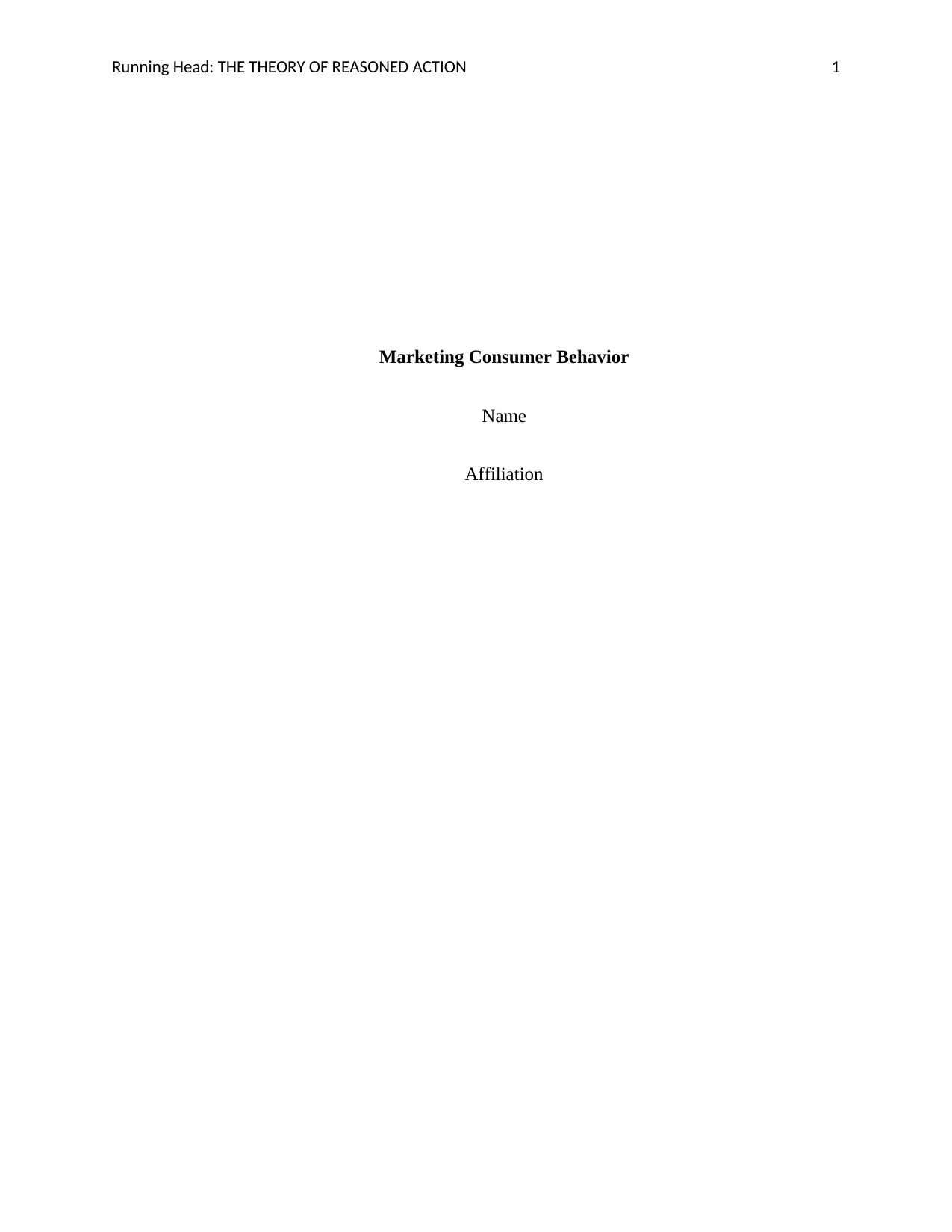
Running Head: THE THEORY OF REASONED ACTION 1
Marketing Consumer Behavior
Name
Affiliation
Marketing Consumer Behavior
Name
Affiliation
Paraphrase This Document
Need a fresh take? Get an instant paraphrase of this document with our AI Paraphraser
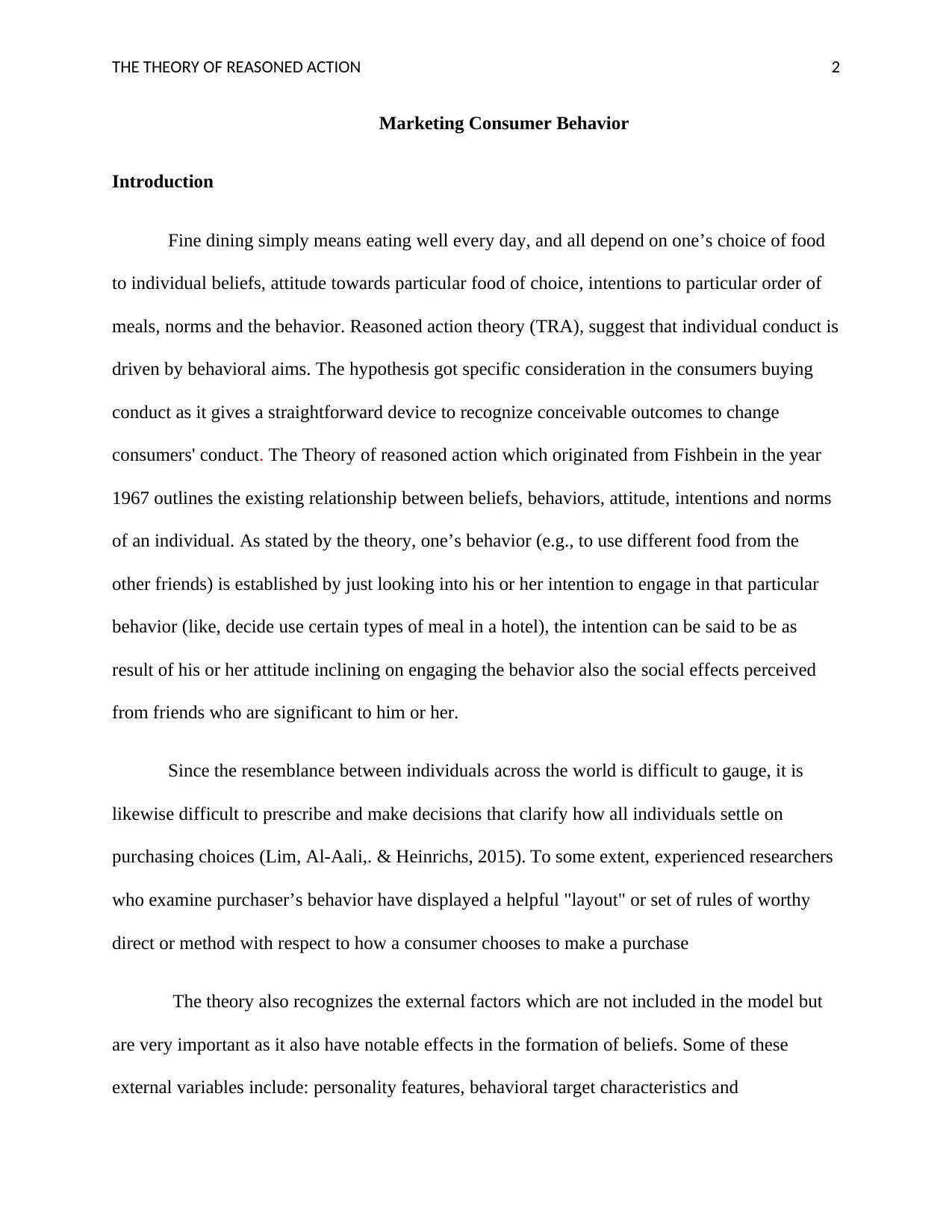
THE THEORY OF REASONED ACTION 2
Marketing Consumer Behavior
Introduction
Fine dining simply means eating well every day, and all depend on one’s choice of food
to individual beliefs, attitude towards particular food of choice, intentions to particular order of
meals, norms and the behavior. Reasoned action theory (TRA), suggest that individual conduct is
driven by behavioral aims. The hypothesis got specific consideration in the consumers buying
conduct as it gives a straightforward device to recognize conceivable outcomes to change
consumers' conduct. The Theory of reasoned action which originated from Fishbein in the year
1967 outlines the existing relationship between beliefs, behaviors, attitude, intentions and norms
of an individual. As stated by the theory, one’s behavior (e.g., to use different food from the
other friends) is established by just looking into his or her intention to engage in that particular
behavior (like, decide use certain types of meal in a hotel), the intention can be said to be as
result of his or her attitude inclining on engaging the behavior also the social effects perceived
from friends who are significant to him or her.
Since the resemblance between individuals across the world is difficult to gauge, it is
likewise difficult to prescribe and make decisions that clarify how all individuals settle on
purchasing choices (Lim, Al-Aali,. & Heinrichs, 2015). To some extent, experienced researchers
who examine purchaser’s behavior have displayed a helpful "layout" or set of rules of worthy
direct or method with respect to how a consumer chooses to make a purchase
The theory also recognizes the external factors which are not included in the model but
are very important as it also have notable effects in the formation of beliefs. Some of these
external variables include: personality features, behavioral target characteristics and
Marketing Consumer Behavior
Introduction
Fine dining simply means eating well every day, and all depend on one’s choice of food
to individual beliefs, attitude towards particular food of choice, intentions to particular order of
meals, norms and the behavior. Reasoned action theory (TRA), suggest that individual conduct is
driven by behavioral aims. The hypothesis got specific consideration in the consumers buying
conduct as it gives a straightforward device to recognize conceivable outcomes to change
consumers' conduct. The Theory of reasoned action which originated from Fishbein in the year
1967 outlines the existing relationship between beliefs, behaviors, attitude, intentions and norms
of an individual. As stated by the theory, one’s behavior (e.g., to use different food from the
other friends) is established by just looking into his or her intention to engage in that particular
behavior (like, decide use certain types of meal in a hotel), the intention can be said to be as
result of his or her attitude inclining on engaging the behavior also the social effects perceived
from friends who are significant to him or her.
Since the resemblance between individuals across the world is difficult to gauge, it is
likewise difficult to prescribe and make decisions that clarify how all individuals settle on
purchasing choices (Lim, Al-Aali,. & Heinrichs, 2015). To some extent, experienced researchers
who examine purchaser’s behavior have displayed a helpful "layout" or set of rules of worthy
direct or method with respect to how a consumer chooses to make a purchase
The theory also recognizes the external factors which are not included in the model but
are very important as it also have notable effects in the formation of beliefs. Some of these
external variables include: personality features, behavioral target characteristics and
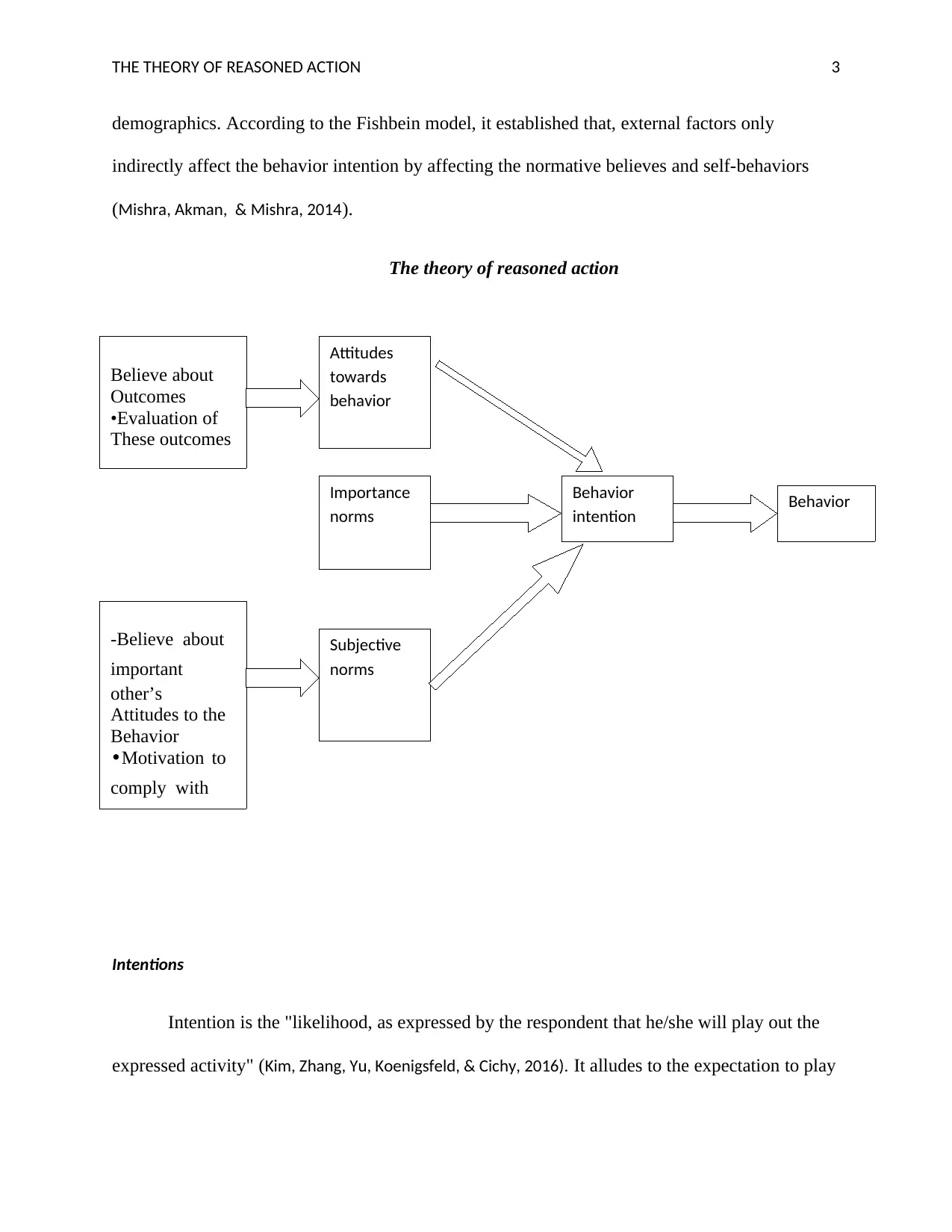
THE THEORY OF REASONED ACTION 3
demographics. According to the Fishbein model, it established that, external factors only
indirectly affect the behavior intention by affecting the normative believes and self-behaviors
(Mishra, Akman, & Mishra, 2014).
The theory of reasoned action
Intentions
Intention is the "likelihood, as expressed by the respondent that he/she will play out the
expressed activity" (Kim, Zhang, Yu, Koenigsfeld, & Cichy, 2016). It alludes to the expectation to play
Believe about
Outcomes
•Evaluation of
These outcomes
-Believe about
important
other’s
Attitudes to the
Behavior
•Motivation to
comply with
important others
Subjective
norms
Importance
norms
Attitudes
towards
behavior
Behavior
intention Behavior
demographics. According to the Fishbein model, it established that, external factors only
indirectly affect the behavior intention by affecting the normative believes and self-behaviors
(Mishra, Akman, & Mishra, 2014).
The theory of reasoned action
Intentions
Intention is the "likelihood, as expressed by the respondent that he/she will play out the
expressed activity" (Kim, Zhang, Yu, Koenigsfeld, & Cichy, 2016). It alludes to the expectation to play
Believe about
Outcomes
•Evaluation of
These outcomes
-Believe about
important
other’s
Attitudes to the
Behavior
•Motivation to
comply with
important others
Subjective
norms
Importance
norms
Attitudes
towards
behavior
Behavior
intention Behavior
⊘ This is a preview!⊘
Do you want full access?
Subscribe today to unlock all pages.

Trusted by 1+ million students worldwide
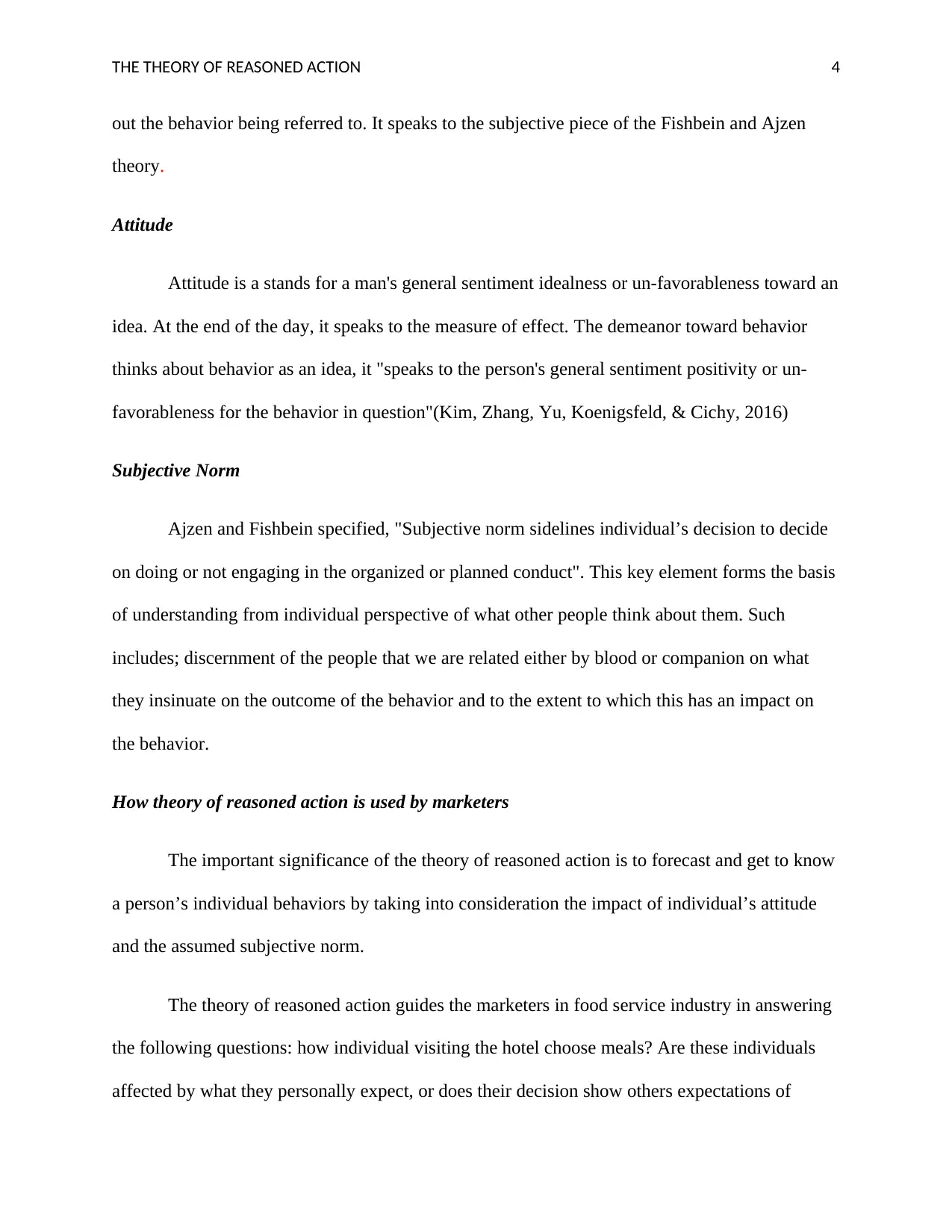
THE THEORY OF REASONED ACTION 4
out the behavior being referred to. It speaks to the subjective piece of the Fishbein and Ajzen
theory.
Attitude
Attitude is a stands for a man's general sentiment idealness or un-favorableness toward an
idea. At the end of the day, it speaks to the measure of effect. The demeanor toward behavior
thinks about behavior as an idea, it "speaks to the person's general sentiment positivity or un-
favorableness for the behavior in question"(Kim, Zhang, Yu, Koenigsfeld, & Cichy, 2016)
Subjective Norm
Ajzen and Fishbein specified, "Subjective norm sidelines individual’s decision to decide
on doing or not engaging in the organized or planned conduct". This key element forms the basis
of understanding from individual perspective of what other people think about them. Such
includes; discernment of the people that we are related either by blood or companion on what
they insinuate on the outcome of the behavior and to the extent to which this has an impact on
the behavior.
How theory of reasoned action is used by marketers
The important significance of the theory of reasoned action is to forecast and get to know
a person’s individual behaviors by taking into consideration the impact of individual’s attitude
and the assumed subjective norm.
The theory of reasoned action guides the marketers in food service industry in answering
the following questions: how individual visiting the hotel choose meals? Are these individuals
affected by what they personally expect, or does their decision show others expectations of
out the behavior being referred to. It speaks to the subjective piece of the Fishbein and Ajzen
theory.
Attitude
Attitude is a stands for a man's general sentiment idealness or un-favorableness toward an
idea. At the end of the day, it speaks to the measure of effect. The demeanor toward behavior
thinks about behavior as an idea, it "speaks to the person's general sentiment positivity or un-
favorableness for the behavior in question"(Kim, Zhang, Yu, Koenigsfeld, & Cichy, 2016)
Subjective Norm
Ajzen and Fishbein specified, "Subjective norm sidelines individual’s decision to decide
on doing or not engaging in the organized or planned conduct". This key element forms the basis
of understanding from individual perspective of what other people think about them. Such
includes; discernment of the people that we are related either by blood or companion on what
they insinuate on the outcome of the behavior and to the extent to which this has an impact on
the behavior.
How theory of reasoned action is used by marketers
The important significance of the theory of reasoned action is to forecast and get to know
a person’s individual behaviors by taking into consideration the impact of individual’s attitude
and the assumed subjective norm.
The theory of reasoned action guides the marketers in food service industry in answering
the following questions: how individual visiting the hotel choose meals? Are these individuals
affected by what they personally expect, or does their decision show others expectations of
Paraphrase This Document
Need a fresh take? Get an instant paraphrase of this document with our AI Paraphraser
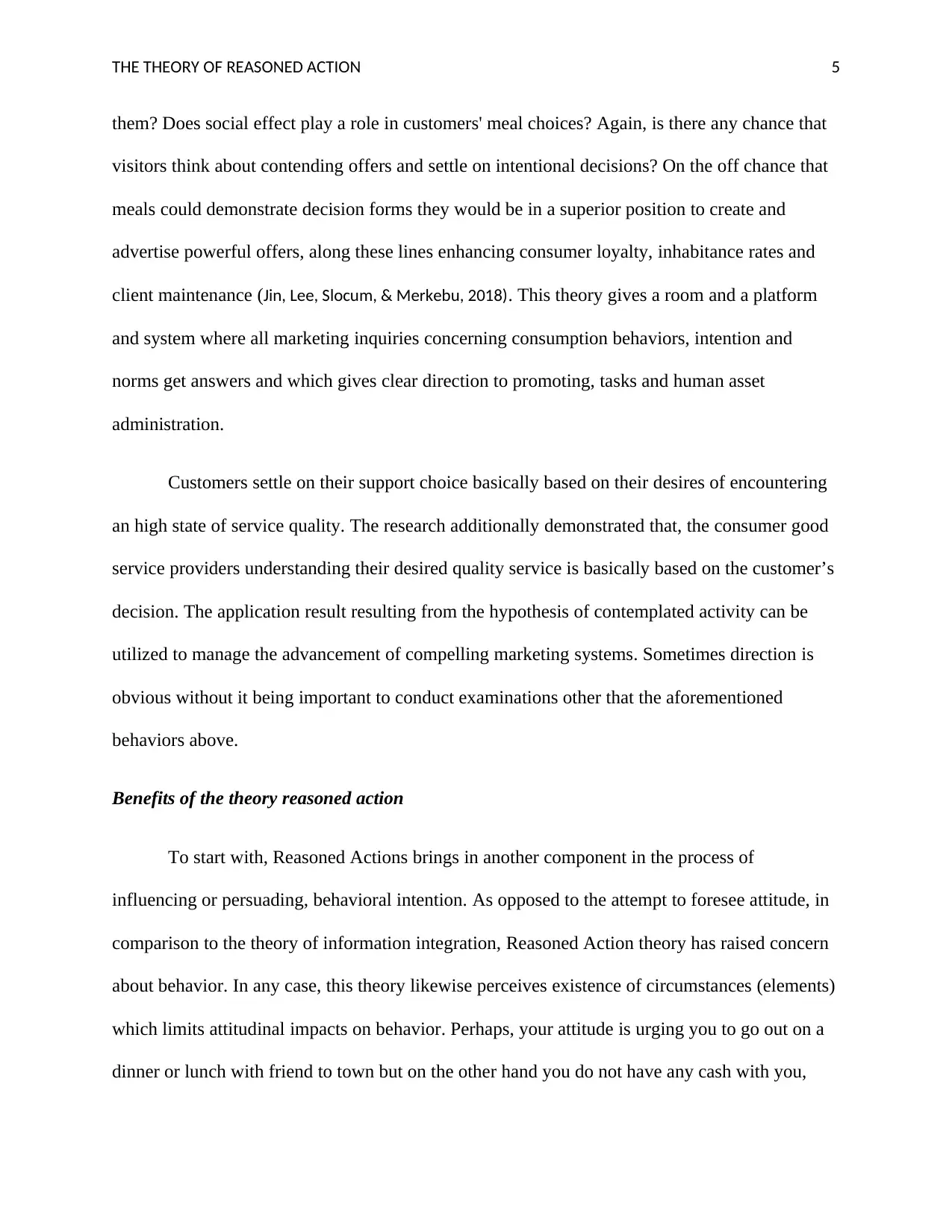
THE THEORY OF REASONED ACTION 5
them? Does social effect play a role in customers' meal choices? Again, is there any chance that
visitors think about contending offers and settle on intentional decisions? On the off chance that
meals could demonstrate decision forms they would be in a superior position to create and
advertise powerful offers, along these lines enhancing consumer loyalty, inhabitance rates and
client maintenance (Jin, Lee, Slocum, & Merkebu, 2018). This theory gives a room and a platform
and system where all marketing inquiries concerning consumption behaviors, intention and
norms get answers and which gives clear direction to promoting, tasks and human asset
administration.
Customers settle on their support choice basically based on their desires of encountering
an high state of service quality. The research additionally demonstrated that, the consumer good
service providers understanding their desired quality service is basically based on the customer’s
decision. The application result resulting from the hypothesis of contemplated activity can be
utilized to manage the advancement of compelling marketing systems. Sometimes direction is
obvious without it being important to conduct examinations other that the aforementioned
behaviors above.
Benefits of the theory reasoned action
To start with, Reasoned Actions brings in another component in the process of
influencing or persuading, behavioral intention. As opposed to the attempt to foresee attitude, in
comparison to the theory of information integration, Reasoned Action theory has raised concern
about behavior. In any case, this theory likewise perceives existence of circumstances (elements)
which limits attitudinal impacts on behavior. Perhaps, your attitude is urging you to go out on a
dinner or lunch with friend to town but on the other hand you do not have any cash with you,
them? Does social effect play a role in customers' meal choices? Again, is there any chance that
visitors think about contending offers and settle on intentional decisions? On the off chance that
meals could demonstrate decision forms they would be in a superior position to create and
advertise powerful offers, along these lines enhancing consumer loyalty, inhabitance rates and
client maintenance (Jin, Lee, Slocum, & Merkebu, 2018). This theory gives a room and a platform
and system where all marketing inquiries concerning consumption behaviors, intention and
norms get answers and which gives clear direction to promoting, tasks and human asset
administration.
Customers settle on their support choice basically based on their desires of encountering
an high state of service quality. The research additionally demonstrated that, the consumer good
service providers understanding their desired quality service is basically based on the customer’s
decision. The application result resulting from the hypothesis of contemplated activity can be
utilized to manage the advancement of compelling marketing systems. Sometimes direction is
obvious without it being important to conduct examinations other that the aforementioned
behaviors above.
Benefits of the theory reasoned action
To start with, Reasoned Actions brings in another component in the process of
influencing or persuading, behavioral intention. As opposed to the attempt to foresee attitude, in
comparison to the theory of information integration, Reasoned Action theory has raised concern
about behavior. In any case, this theory likewise perceives existence of circumstances (elements)
which limits attitudinal impacts on behavior. Perhaps, your attitude is urging you to go out on a
dinner or lunch with friend to town but on the other hand you do not have any cash with you,
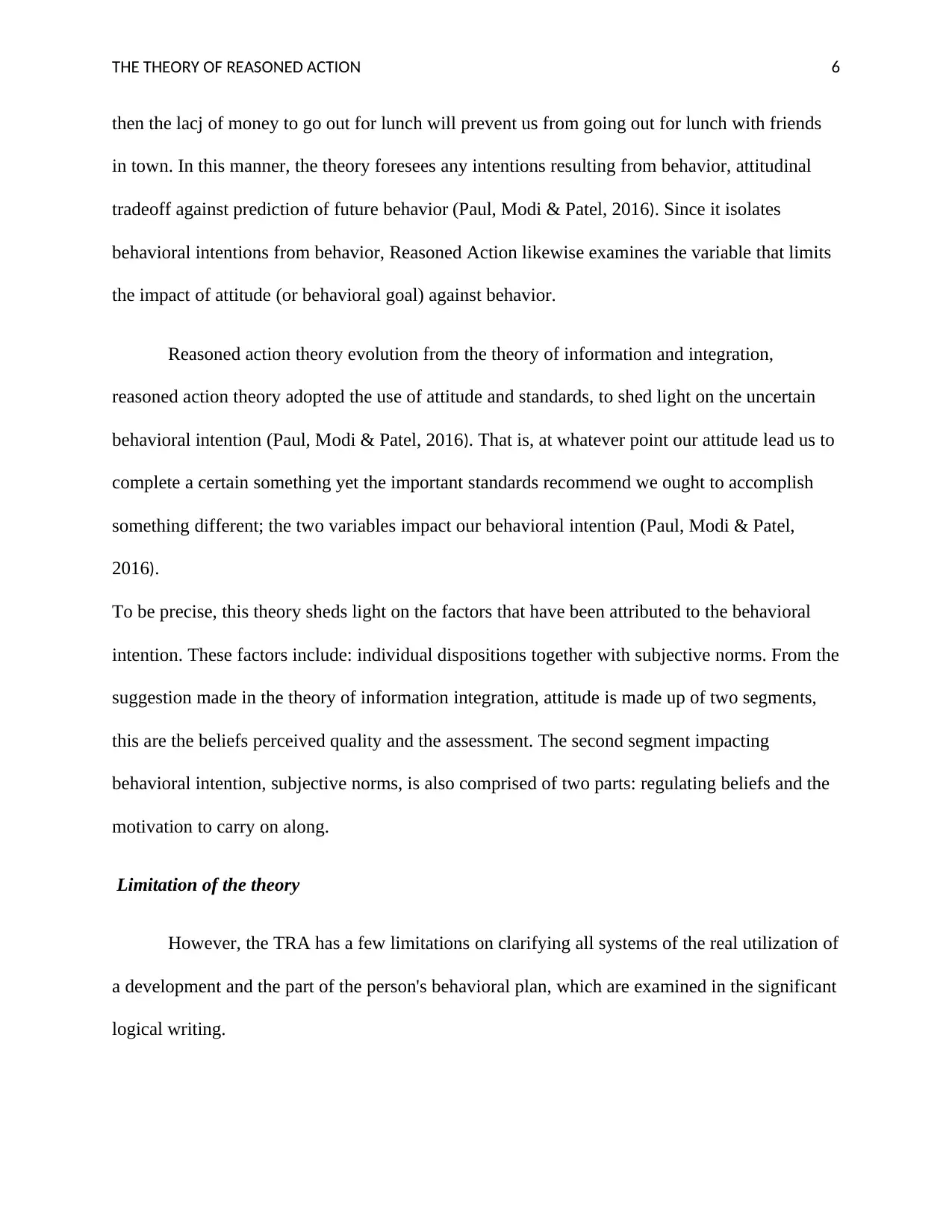
THE THEORY OF REASONED ACTION 6
then the lacj of money to go out for lunch will prevent us from going out for lunch with friends
in town. In this manner, the theory foresees any intentions resulting from behavior, attitudinal
tradeoff against prediction of future behavior (Paul, Modi & Patel, 2016). Since it isolates
behavioral intentions from behavior, Reasoned Action likewise examines the variable that limits
the impact of attitude (or behavioral goal) against behavior.
Reasoned action theory evolution from the theory of information and integration,
reasoned action theory adopted the use of attitude and standards, to shed light on the uncertain
behavioral intention (Paul, Modi & Patel, 2016). That is, at whatever point our attitude lead us to
complete a certain something yet the important standards recommend we ought to accomplish
something different; the two variables impact our behavioral intention (Paul, Modi & Patel,
2016).
To be precise, this theory sheds light on the factors that have been attributed to the behavioral
intention. These factors include: individual dispositions together with subjective norms. From the
suggestion made in the theory of information integration, attitude is made up of two segments,
this are the beliefs perceived quality and the assessment. The second segment impacting
behavioral intention, subjective norms, is also comprised of two parts: regulating beliefs and the
motivation to carry on along.
Limitation of the theory
However, the TRA has a few limitations on clarifying all systems of the real utilization of
a development and the part of the person's behavioral plan, which are examined in the significant
logical writing.
then the lacj of money to go out for lunch will prevent us from going out for lunch with friends
in town. In this manner, the theory foresees any intentions resulting from behavior, attitudinal
tradeoff against prediction of future behavior (Paul, Modi & Patel, 2016). Since it isolates
behavioral intentions from behavior, Reasoned Action likewise examines the variable that limits
the impact of attitude (or behavioral goal) against behavior.
Reasoned action theory evolution from the theory of information and integration,
reasoned action theory adopted the use of attitude and standards, to shed light on the uncertain
behavioral intention (Paul, Modi & Patel, 2016). That is, at whatever point our attitude lead us to
complete a certain something yet the important standards recommend we ought to accomplish
something different; the two variables impact our behavioral intention (Paul, Modi & Patel,
2016).
To be precise, this theory sheds light on the factors that have been attributed to the behavioral
intention. These factors include: individual dispositions together with subjective norms. From the
suggestion made in the theory of information integration, attitude is made up of two segments,
this are the beliefs perceived quality and the assessment. The second segment impacting
behavioral intention, subjective norms, is also comprised of two parts: regulating beliefs and the
motivation to carry on along.
Limitation of the theory
However, the TRA has a few limitations on clarifying all systems of the real utilization of
a development and the part of the person's behavioral plan, which are examined in the significant
logical writing.
⊘ This is a preview!⊘
Do you want full access?
Subscribe today to unlock all pages.

Trusted by 1+ million students worldwide
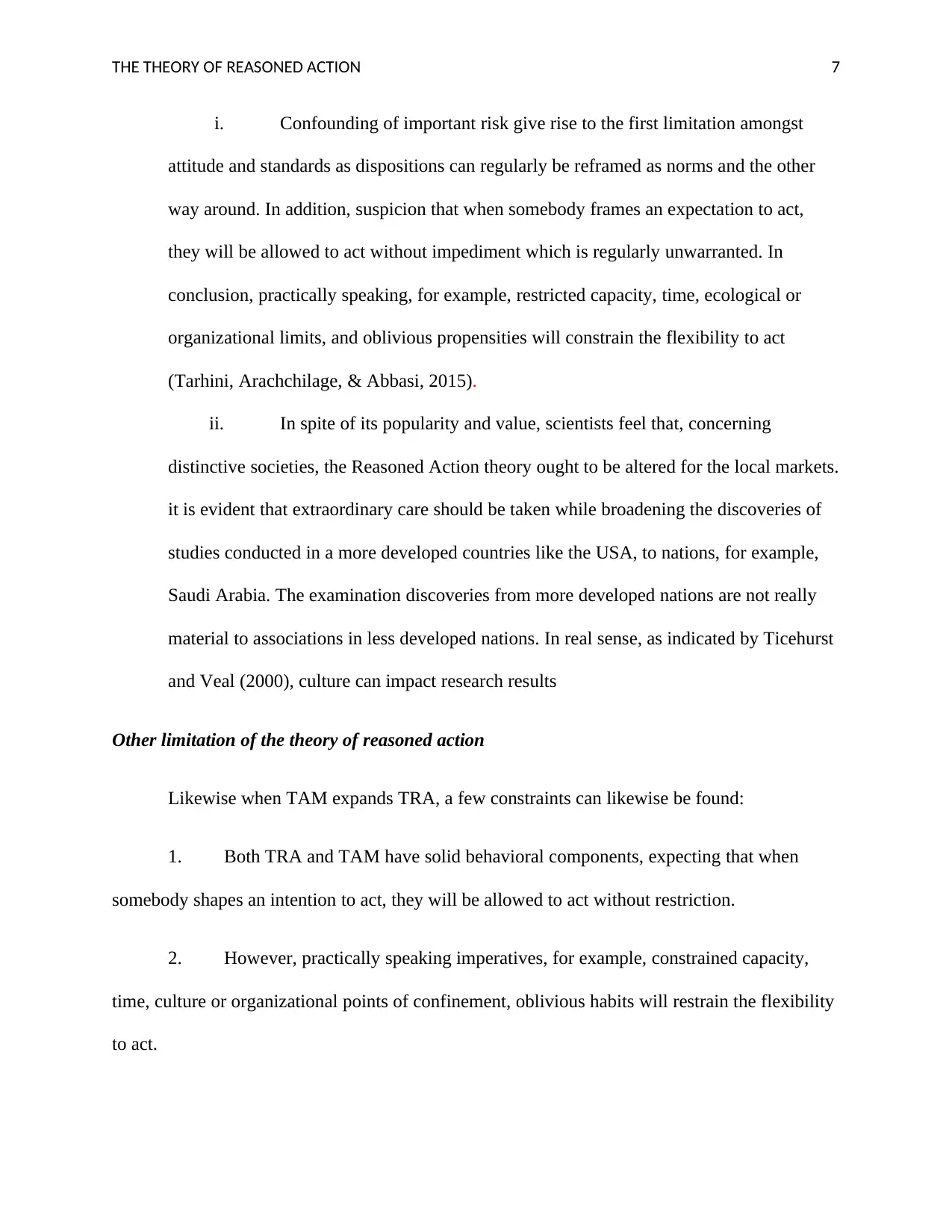
THE THEORY OF REASONED ACTION 7
i. Confounding of important risk give rise to the first limitation amongst
attitude and standards as dispositions can regularly be reframed as norms and the other
way around. In addition, suspicion that when somebody frames an expectation to act,
they will be allowed to act without impediment which is regularly unwarranted. In
conclusion, practically speaking, for example, restricted capacity, time, ecological or
organizational limits, and oblivious propensities will constrain the flexibility to act
(Tarhini, Arachchilage, & Abbasi, 2015).
ii. In spite of its popularity and value, scientists feel that, concerning
distinctive societies, the Reasoned Action theory ought to be altered for the local markets.
it is evident that extraordinary care should be taken while broadening the discoveries of
studies conducted in a more developed countries like the USA, to nations, for example,
Saudi Arabia. The examination discoveries from more developed nations are not really
material to associations in less developed nations. In real sense, as indicated by Ticehurst
and Veal (2000), culture can impact research results
Other limitation of the theory of reasoned action
Likewise when TAM expands TRA, a few constraints can likewise be found:
1. Both TRA and TAM have solid behavioral components, expecting that when
somebody shapes an intention to act, they will be allowed to act without restriction.
2. However, practically speaking imperatives, for example, constrained capacity,
time, culture or organizational points of confinement, oblivious habits will restrain the flexibility
to act.
i. Confounding of important risk give rise to the first limitation amongst
attitude and standards as dispositions can regularly be reframed as norms and the other
way around. In addition, suspicion that when somebody frames an expectation to act,
they will be allowed to act without impediment which is regularly unwarranted. In
conclusion, practically speaking, for example, restricted capacity, time, ecological or
organizational limits, and oblivious propensities will constrain the flexibility to act
(Tarhini, Arachchilage, & Abbasi, 2015).
ii. In spite of its popularity and value, scientists feel that, concerning
distinctive societies, the Reasoned Action theory ought to be altered for the local markets.
it is evident that extraordinary care should be taken while broadening the discoveries of
studies conducted in a more developed countries like the USA, to nations, for example,
Saudi Arabia. The examination discoveries from more developed nations are not really
material to associations in less developed nations. In real sense, as indicated by Ticehurst
and Veal (2000), culture can impact research results
Other limitation of the theory of reasoned action
Likewise when TAM expands TRA, a few constraints can likewise be found:
1. Both TRA and TAM have solid behavioral components, expecting that when
somebody shapes an intention to act, they will be allowed to act without restriction.
2. However, practically speaking imperatives, for example, constrained capacity,
time, culture or organizational points of confinement, oblivious habits will restrain the flexibility
to act.
Paraphrase This Document
Need a fresh take? Get an instant paraphrase of this document with our AI Paraphraser
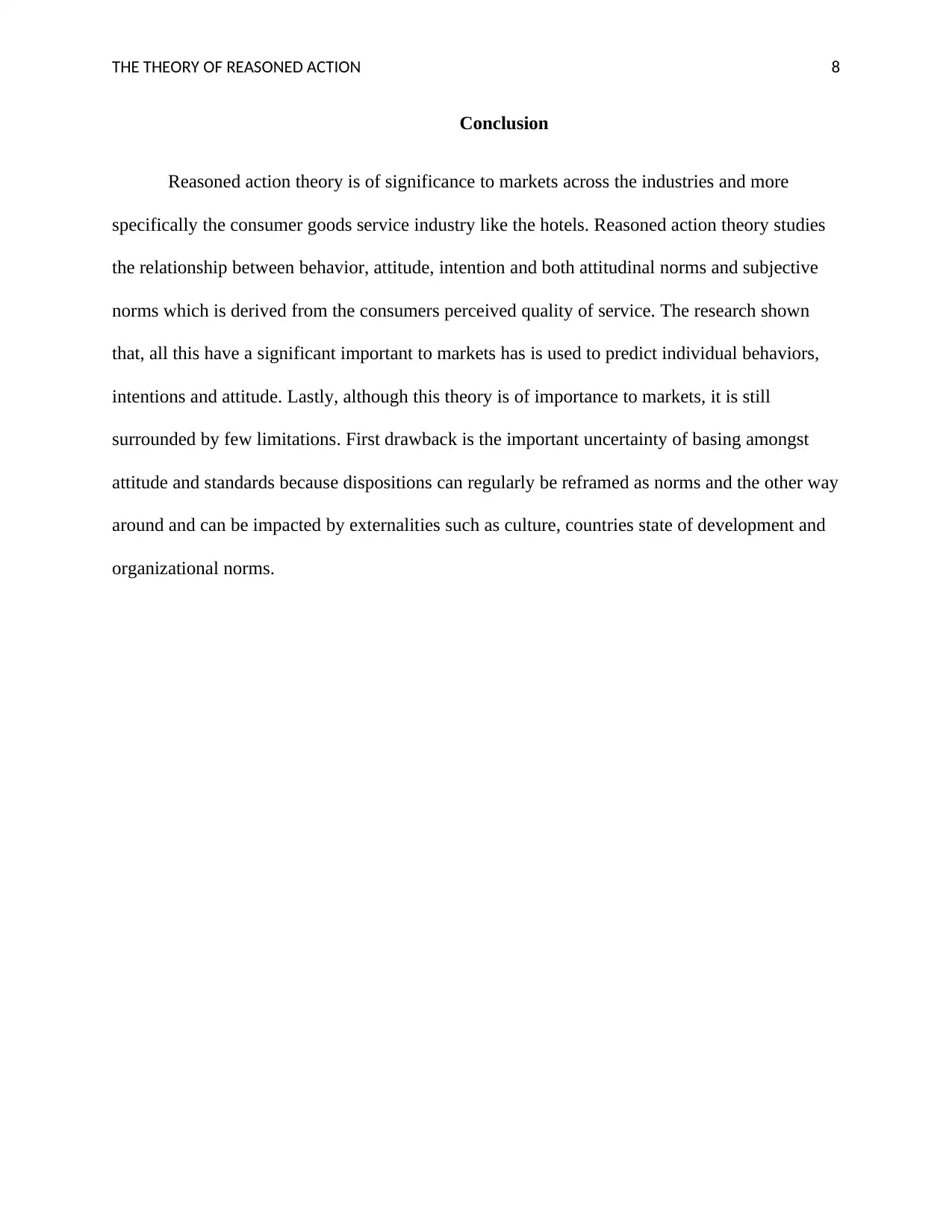
THE THEORY OF REASONED ACTION 8
Conclusion
Reasoned action theory is of significance to markets across the industries and more
specifically the consumer goods service industry like the hotels. Reasoned action theory studies
the relationship between behavior, attitude, intention and both attitudinal norms and subjective
norms which is derived from the consumers perceived quality of service. The research shown
that, all this have a significant important to markets has is used to predict individual behaviors,
intentions and attitude. Lastly, although this theory is of importance to markets, it is still
surrounded by few limitations. First drawback is the important uncertainty of basing amongst
attitude and standards because dispositions can regularly be reframed as norms and the other way
around and can be impacted by externalities such as culture, countries state of development and
organizational norms.
Conclusion
Reasoned action theory is of significance to markets across the industries and more
specifically the consumer goods service industry like the hotels. Reasoned action theory studies
the relationship between behavior, attitude, intention and both attitudinal norms and subjective
norms which is derived from the consumers perceived quality of service. The research shown
that, all this have a significant important to markets has is used to predict individual behaviors,
intentions and attitude. Lastly, although this theory is of importance to markets, it is still
surrounded by few limitations. First drawback is the important uncertainty of basing amongst
attitude and standards because dispositions can regularly be reframed as norms and the other way
around and can be impacted by externalities such as culture, countries state of development and
organizational norms.
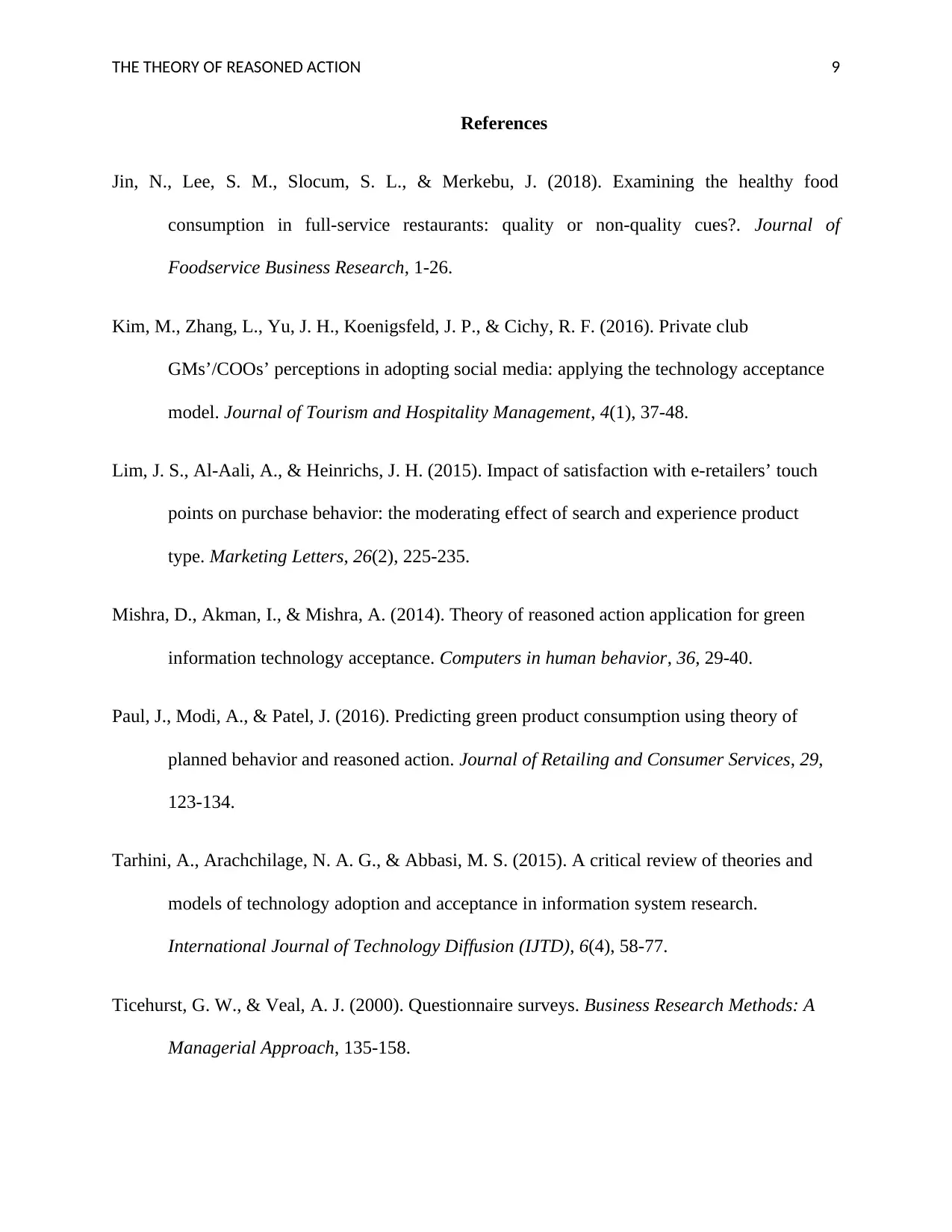
THE THEORY OF REASONED ACTION 9
References
Jin, N., Lee, S. M., Slocum, S. L., & Merkebu, J. (2018). Examining the healthy food
consumption in full-service restaurants: quality or non-quality cues?. Journal of
Foodservice Business Research, 1-26.
Kim, M., Zhang, L., Yu, J. H., Koenigsfeld, J. P., & Cichy, R. F. (2016). Private club
GMs’/COOs’ perceptions in adopting social media: applying the technology acceptance
model. Journal of Tourism and Hospitality Management, 4(1), 37-48.
Lim, J. S., Al-Aali, A., & Heinrichs, J. H. (2015). Impact of satisfaction with e-retailers’ touch
points on purchase behavior: the moderating effect of search and experience product
type. Marketing Letters, 26(2), 225-235.
Mishra, D., Akman, I., & Mishra, A. (2014). Theory of reasoned action application for green
information technology acceptance. Computers in human behavior, 36, 29-40.
Paul, J., Modi, A., & Patel, J. (2016). Predicting green product consumption using theory of
planned behavior and reasoned action. Journal of Retailing and Consumer Services, 29,
123-134.
Tarhini, A., Arachchilage, N. A. G., & Abbasi, M. S. (2015). A critical review of theories and
models of technology adoption and acceptance in information system research.
International Journal of Technology Diffusion (IJTD), 6(4), 58-77.
Ticehurst, G. W., & Veal, A. J. (2000). Questionnaire surveys. Business Research Methods: A
Managerial Approach, 135-158.
References
Jin, N., Lee, S. M., Slocum, S. L., & Merkebu, J. (2018). Examining the healthy food
consumption in full-service restaurants: quality or non-quality cues?. Journal of
Foodservice Business Research, 1-26.
Kim, M., Zhang, L., Yu, J. H., Koenigsfeld, J. P., & Cichy, R. F. (2016). Private club
GMs’/COOs’ perceptions in adopting social media: applying the technology acceptance
model. Journal of Tourism and Hospitality Management, 4(1), 37-48.
Lim, J. S., Al-Aali, A., & Heinrichs, J. H. (2015). Impact of satisfaction with e-retailers’ touch
points on purchase behavior: the moderating effect of search and experience product
type. Marketing Letters, 26(2), 225-235.
Mishra, D., Akman, I., & Mishra, A. (2014). Theory of reasoned action application for green
information technology acceptance. Computers in human behavior, 36, 29-40.
Paul, J., Modi, A., & Patel, J. (2016). Predicting green product consumption using theory of
planned behavior and reasoned action. Journal of Retailing and Consumer Services, 29,
123-134.
Tarhini, A., Arachchilage, N. A. G., & Abbasi, M. S. (2015). A critical review of theories and
models of technology adoption and acceptance in information system research.
International Journal of Technology Diffusion (IJTD), 6(4), 58-77.
Ticehurst, G. W., & Veal, A. J. (2000). Questionnaire surveys. Business Research Methods: A
Managerial Approach, 135-158.
⊘ This is a preview!⊘
Do you want full access?
Subscribe today to unlock all pages.

Trusted by 1+ million students worldwide
1 out of 9
Related Documents
Your All-in-One AI-Powered Toolkit for Academic Success.
+13062052269
info@desklib.com
Available 24*7 on WhatsApp / Email
![[object Object]](/_next/static/media/star-bottom.7253800d.svg)
Unlock your academic potential
Copyright © 2020–2025 A2Z Services. All Rights Reserved. Developed and managed by ZUCOL.




